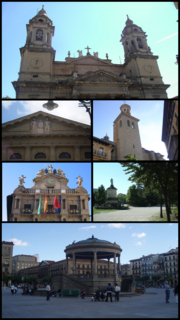
Tomás de Zumalacárregui e Imaz, 1st Duke of the Victory of the Amezcoas, 1st Count of Zumalacárregui, GE, OSH, known among his troops as "Uncle Tomás", was a Spanish Basque officer who lead the Carlist faction as Captain general of the Army during the First Carlist War. He was ocassionaly nicknamed the "Wolf of the Amezcoas", making reference to his famous military victory in said region of Navarre.
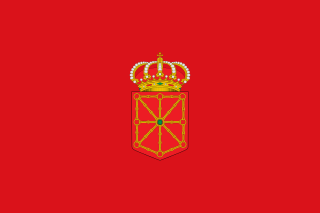
Navarre ; officially the Chartered Community of Navarre, is an autonomous community and province in northern Spain, bordering the Basque Autonomous Community, La Rioja, and Aragon in Spain and Nouvelle-Aquitaine in France. The capital city is Pamplona.

Basque nationalism is a form of nationalism that asserts that Basques, an ethnic group indigenous to the western Pyrenees, are a nation, and promotes the political unity of the Basques. Since its inception in the late 19th century, Basque nationalism has included separatist movements.

Carlism is a Traditionalist and legitimist political movement in Spain seeking to take the Spanish throne for a line of the Bourbon dynasty descended from Don Carlos, Count of Molina (1788–1855). The movement was founded due to dispute over the succession laws and widespread dissatisfaction with the Alfonsine line of the House of Bourbon. The movement was at its strongest in the 1830s but had a revival following Spain's defeat in the Spanish–American War in 1898, when Spain lost its last remaining significant overseas territories of Cuba, Guam, the Philippines, and Puerto Rico to the United States.

The Kingdom of Navarre, originally the Kingdom of Pamplona, was a Basque-based kingdom that occupied lands on either side of the western Pyrenees, alongside the Atlantic Ocean between present-day Spain and France.
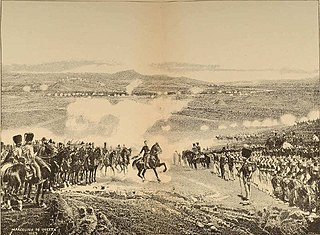
The First Carlist War was a civil war in Spain from 1833 to 1840, fought between factions over the succession to the throne and the nature of the Spanish monarchy. It was fought between supporters of the regent, Maria Christina, acting for Isabella II of Spain, and those of the late king's brother, Carlos de Borbón. The Carlists’ goal was the return to an absolute monarchy. Portugal, France and the United Kingdom supported the regency, and sent volunteer and even regular forces to confront the Carlist army.

Estella (Spanish) or Lizarra (Basque) is a town located in the autonomous community of Navarre, in northern Spain. It lies south west of Pamplona, close to the border with La Rioja and Álava.
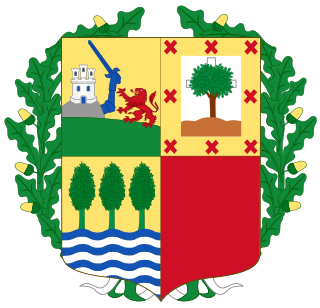
The Statute of Autonomy of the Basque Country, widely known as the Statute of Gernika, is the legal document organizing the political system of the Autonomous Community of the Basque Country' which includes the historical territories of Alava, Biscay and Gipuzkoa. It forms the region into one of the autonomous communities envisioned in the Spanish Constitution of 1978. The Statute was named "Statute of Gernika" after the city of Gernika, where its final form was approved on 29 December 1978. It was ratified by referendum on 25 October 1979, despite the abstention of more than 40% of the electorate. The statute was accepted by the lower house of the Spanish Parliament on November 29 and the Spanish Senate on December 12.

The Basques are an indigenous ethno-linguistic group mainly inhabiting Basque Country. Their history is therefore interconnected with Spanish and French history and also with the history of many other past and present countries, particularly in Europe and the Americas, where a large number of their descendants keep attached to their roots, clustering around Basque clubs.

The Southern Basque Country is a term used to refer to the Basque territories within Spain as a unified whole.
The Battle of Venta de Echavarri, a battle of the First Carlist War, occurred on October 28, 1834. It was an immediate follow-up to the Battle of Alegría de Álava, which had occurred the day before. It was a Carlist victory.
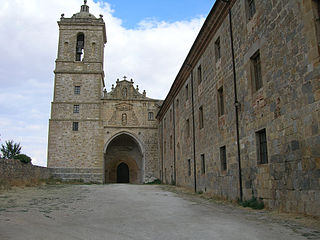
Santa María la Real de Irache is a former Benedictine monastery located in the town of Ayegui, Navarre, Spain. It dates from the eighth century, although the surviving buildings are later.
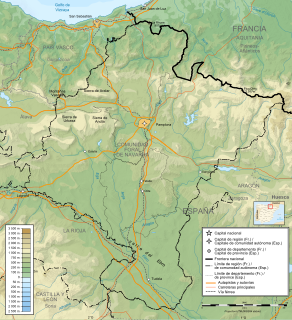
Carlism was the dominant political movement in elections in Navarre during the period between the Third Carlist War and the Primo de Rivera dictatorship. The movement, defeated in 1876, during the Restauración period recalibrated its focus from military action to political means and media campaigns. Accommodating themselves to political framework of the Alfonsine monarchy, party leaders considered elections, and especially elections to Cortes Generales, primary vehicle of political mobilization. Navarre turned out to be the Carlist electoral stronghold; it elected 35% of all Carlist deputies voted into the parliament during almost 50 years of the monarchical liberal democracy. Though the phenomenon remained marginal from the national Spanish perspective, political prowess of Carlism in the province was key to sustain its potential until the movement regained momentum during the Second Spanish Republic.
The Victims of the Civil War in Navarre resulted from the repression exerted by the rebel forces strong in the area during and following the July 1936 coup d'état. The repression in the rearguard against dissenters and people felt to be inconvenient by the new military authorities lasted for months on with a death toll of thousands.
The end of Basque home rule or fueros in Spain was a process coming to a head in the period extending from the First Carlist War (1833-1840) to the aftermath of the Third Carlist War (1876-1878). It brought to an end the status of sovereignty coupled with allegiance to the Crown of Castile held by the different Basque territories for centuries. In the French Basque Country, home rule was abruptly suppressed during the French Revolution.
The Segovia prison break occurred in Segovia, Spain on 5 April 1976 when 29 political prisoners escaped from Segovia prison. This was the largest prison break in Spain since the Spanish Civil War. The prisoners escaped by means of tunnels they had excavated and then through the prison's drainage system. Hidden in a truck, they fled in the direction of the French border. Before reaching the border, their escape plans broke down and they found themselves stranded and lost in woodland in Navarre. Most of them were recaptured after a confrontation with the Civil Guards in Espinal, during which one of the prisoners was shot dead. The remaining four escapees managed to cross the French border and were detained by the French government, but escaped once again. In 1977, the Spanish authorities declared a general amnesty, after which the escapees were freed or could return to Spain.

The Citadel of Pamplona or The New Castle is an old military renaissance fort, constructed between the 16th and 17th Centuries in the city of Pamplona, the capital of the Navarre Community (Spain). At present a large part of the fort it is still standing in a public park with cultural activities taking place in its buildings.
Maravillas Lamberto was a 14-year-old girl from Larraga, Navarre, who was raped and killed by Falangists, part of the Nationalist faction, during the July 1936 coup d'état which started the Spanish Civil War. The uprising, spearheaded in Navarre by Carlists and General Mola's military forces, was followed by harsh repression against pro-Republican leaders and sympathizers and their families. During this repression Maravillas' father, Vicente Lamberto Martinez was also arrested and summarily executed.


